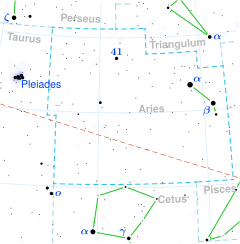
Back Épsilon Arietis AST Èpsilon d'Àries Catalan Épsilon Arietis Spanish اپسیلون بره Persian Epsilon Arietis French Epsilon Arietis ID Epsilon Arietis Italian おひつじ座イプシロン星 Japanese 양자리 엡실론 Korean Epsilon Arietis Portuguese
| Observation data Epoch J2000 Equinox J2000 | |
|---|---|
| Constellation | Aries |
| Right ascension | 02h 59m 12.72536s[1] |
| Declination | +21° 20′ 25.5575″[1] |
| Apparent magnitude (V) | 4.63[2] (5.2/5.5)[3] |
| Characteristics | |
| Spectral type | A2 Vs + A2 Vs[4] |
| U−B color index | +0.08[2] |
| B−V color index | +0.04[2] |
| R−I color index | 0.02 |
| Astrometry | |
| Radial velocity (Rv) | +0.9 ± 0.9[5] km/s |
| Proper motion (μ) | RA: -13.74[1] mas/yr Dec.: -5.12[1] mas/yr |
| Parallax (π) | 9.81 ± 0.79 mas[1] |
| Distance | 330 ± 30 ly (102 ± 8 pc) |
| Orbit[6] | |
| Period (P) | 704.111±1.778 yr |
| Semi-major axis (a) | 2.174±0.035″ |
| Eccentricity (e) | 0.317±0.006 |
| Inclination (i) | 84.2±0.8° |
| Longitude of the node (Ω) | 25.6±0.7° |
| Periastron epoch (T) | 704.111±1.778 |
| Argument of periastron (ω) (secondary) | 162.1±1.0° |
| Details | |
| ε Ari A | |
| Mass | 2.4[6] M☉ |
| Rotational velocity (v sin i) | 60[4] km/s |
| ε Ari B | |
| Mass | 2.4[6] M☉ |
| Rotational velocity (v sin i) | 60[4] km/s |
| Other designations | |
| ε Ari A: HD 18520, HR 888, SAO 75673 | |
| ε Ari B: HD 18519, HR 887. | |
| Database references | |
| SIMBAD | ε Ari |
| ε Ari A | |
| ε Ari B | |
Epsilon Arietis (ε Ari, ε Arietis) is the Bayer designation for a visual binary[8] star system in the northern constellation of Aries. It has a combined apparent visual magnitude of 4.63[2] and can be seen with the naked eye, although the two components are too close together to be resolved without a telescope. With an annual parallax shift of 9.81 mas,[1] the distance to this system can be estimated as 330 light-years (100 parsecs), give or take a 30 light-year margin of error. It is located behind the dark cloud MBM12.[6]
The brighter member of this pair has an apparent magnitude of 5.2.[3] At an angular separation of 1.426 ± 0.010 arcseconds from the brighter component, along a position angle of 209.2° ± 0.3°,[8] is the magnitude 5.5 companion.[3] Both are A-type main sequence stars with a stellar classification of A2 Vs.[4] (The 's' suffix indicates that the absorption lines in the spectrum are distinctly narrow.) In the 2009 Catalogue of Ap, HgMn and Am stars, the two stars have a classification of A3 Ti,[3] indicating they are Ap stars with an anomalous abundance of titanium. Within the measurement margin of error, their projected rotational velocities are deemed identical at 60 km/s.[4]
- ^ a b c d e f Cite error: The named reference
aaa474_2_653was invoked but never defined (see the help page). - ^ a b c d Cite error: The named reference
aj68_697was invoked but never defined (see the help page). - ^ a b c d Cite error: The named reference
aaa498_3_961was invoked but never defined (see the help page). - ^ a b c d e Cite error: The named reference
aaa393_897was invoked but never defined (see the help page). - ^ Cite error: The named reference
al32_11_759was invoked but never defined (see the help page). - ^ a b c d Cite error: The named reference
Rica2012was invoked but never defined (see the help page). - ^ Cite error: The named reference
SIMBADwas invoked but never defined (see the help page). - ^ a b Cite error: The named reference
mnras374_3_965was invoked but never defined (see the help page).
